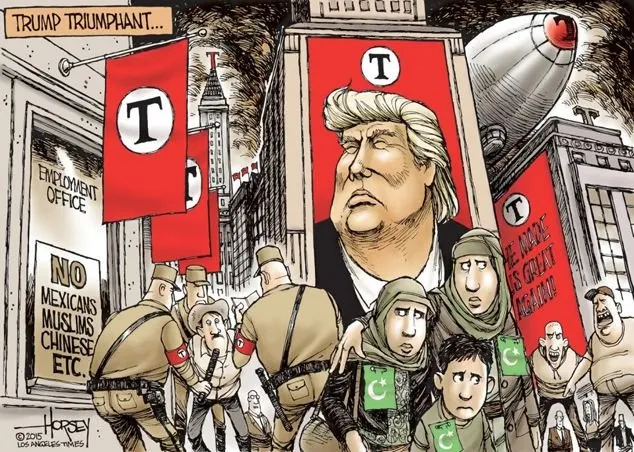Doomsday Clock ticks 30 seconds closer to midnight, thanks to Trump
The apocalyptic clock was created by former Manhattan Project scientists in an effort to bring public attention to the threat of nuclear war. Hovering anywhere between 17 and 2 minutes to midnight since its formation, the minute hand of the clock advances forward to symbolize humanity’s looming demise.
A rise in global nationalism and humanity’s failure to confront nuclear weapons and climate change, scientists today pushed the infamous Doomsday Clock 30 seconds closer to midnight—the symbolic moment humankind is supposed to annihilate itself.
One of the biggest reasons for the move, wrote BAS scientists in an op-ed in The New York Times, was the ascent of U.S. President Donald Trump: “Never before has the Bulletin decided to advance the clock largely because of the statements of a single person,” they wrote. “But Mr. Trump’s statements and actions have been unsettling.”

In a tweet in December 2016, Trump wrote, “The United States must greatly strengthen and expand its nuclear capability until such time as the world comes to its senses regarding nukes.”
A panel of three BAS scientists and a former U.S. ambassador made the announcement, speaking not only of the new U.S. administration, but also about actions to develop nuclear weapons around the globe, including places like North Korea, India, Pakistan, China, and Russia. “It is not time to build up. It is time to continue to build down,” former U.S. Ambassador to the United Nations Thomas Pickering said when asked about U.S. and Russian nuclear capabilities, which now account for 90% of the world’s nuclear arms.
Here’s a breakdown of every change for the last 60 years:
- 1947: 7 minutes to midnight—First effort to convey weight of nuclear dangers to public using the Doomsday Clock
- 1949: 3 minutes to midnight—Start of the nuclear arms race
- 1953: 2 minutes to midnight—The United States and the Soviet Union test thermonuclear devices for the first time.
- 1960: 7 minutes to midnight—Steps made to avoid direct nuclear confrontation in regional conflict
- 1963: 12 minutes to midnight—The United States and the Soviet Union sign the Partial Test Ban Treaty, ending all atmospheric nuclear testing.
- 1968: 7 minutes to midnight—Regional wars amplify, including U.S. involvement in Vietnam and tensions between India and Pakistan
- 1969: 10 minutes to midnight—Nations sign nuclear nonproliferation treaty
- 1972: 12 minutes to midnight—The United States and the Soviet Union sign the Strategic Arms Limitation treaty and Anti-Ballistic Missile Treaty, slowing nuclear arms race.
- 1974: 9 minutes to midnight—India tests its first nuclear device; the United States and the Soviet Union seem to modernize weapons, rather than reduce stock.
- 1980: 7 minutes to midnight—General stagnation in efforts to diminish nuclear weapons
- 1981: 4 minutes to midnight—The Soviet Union invades Afghanistan; former U.S. President Ronald Reagan “scraps any talk” of arms control in Cold War.
- 1984: 3 minutes to midnight—U.S. and Soviet communication goes silent; the United States mulls space-based missile capacity.
- 1988: 6 minutes to midnight—The United States and the Soviet Union sign the Intermediate-Range Nuclear Forces Treaty, which bans the use of intermediate-range missiles outright.
- 1990: 10 minutes to midnight—Eastern European countries gain independence from the Soviet Union, following the fall of Berlin Wall in late 1989.
- 1991: 17 minutes to midnight—Cold War ends. The United States and Russia make significant reductions to respective nuclear arsenals.
- 1995: 14 minutes to midnight—Concern over possible Russian resurgence grows, slowing nuclear rollback efforts.
- 1998: 9 minutes to midnight—India and Pakistan stage back-to-back nuclear weapons tests.
- 2002: 7 minutes to midnight—Worry of nuclear terrorist attacks rise; the United States withdraws from the Anti-Ballistic Missile Treaty.
- 2007: 5 minutes to midnight—Climate change data present new threat to humanity; North Korea conducts nuclear testing.
- 2010: 6 minutes to midnight—Strides made toward Strategic Arms reduction Treaty between the United States and Russia; knowledge of the impact of climate change grows, but the Copenhagen Accord sets tone to slow global temperature rise.
- 2012: 5 minutes to midnight—Potential for nuclear conflict in the Middle East, Northeast Asia, and South Asia increases; technological solutions to climate change lack promise
- 2015: 3 minutes to midnight—BAS states: “Unchecked climate change, global nuclear weapons modernizations, and outsized nuclear weapons arsenals pose extraordinary and undeniable threats to the continued existence of humanity.”
- 2016: 3 minutes to midnight—Lack of action from world leaders leaves the clock stagnant.
- 2017: 2.5 minutes to midnight—World leaders fail to address nuclear weapons, climate change, and rising nationalism.